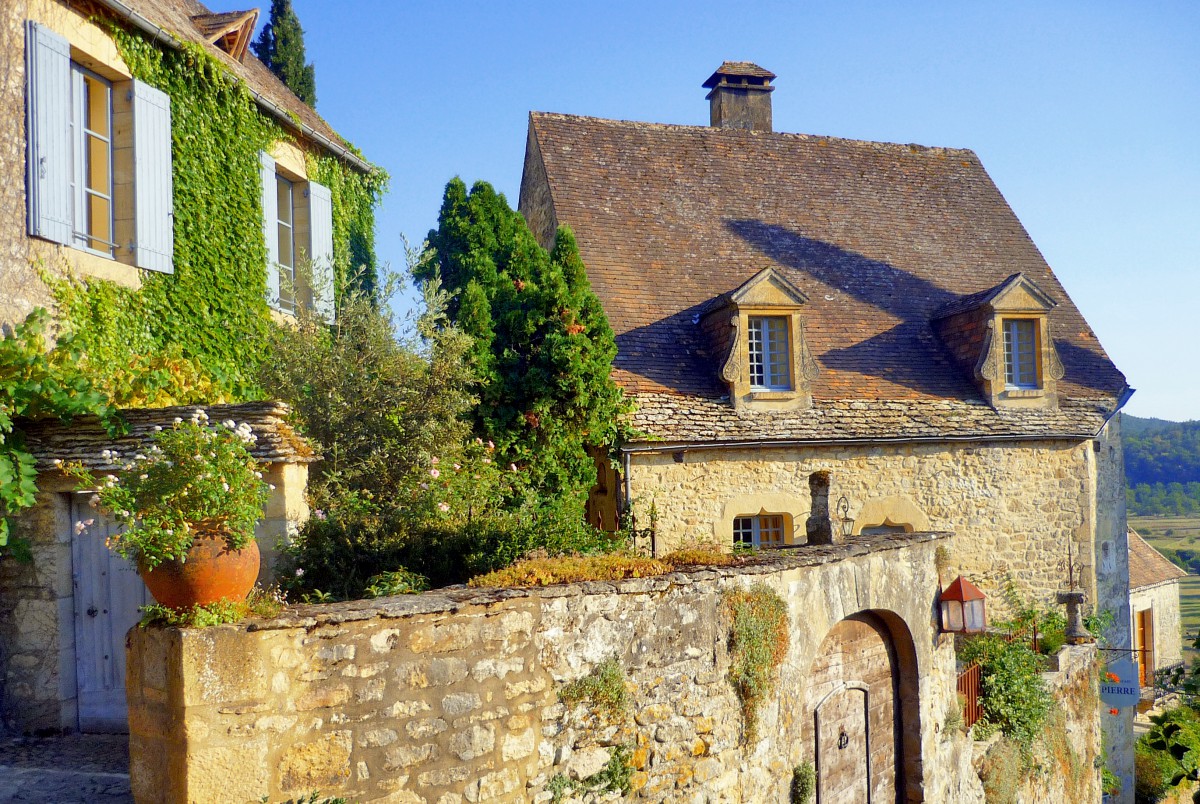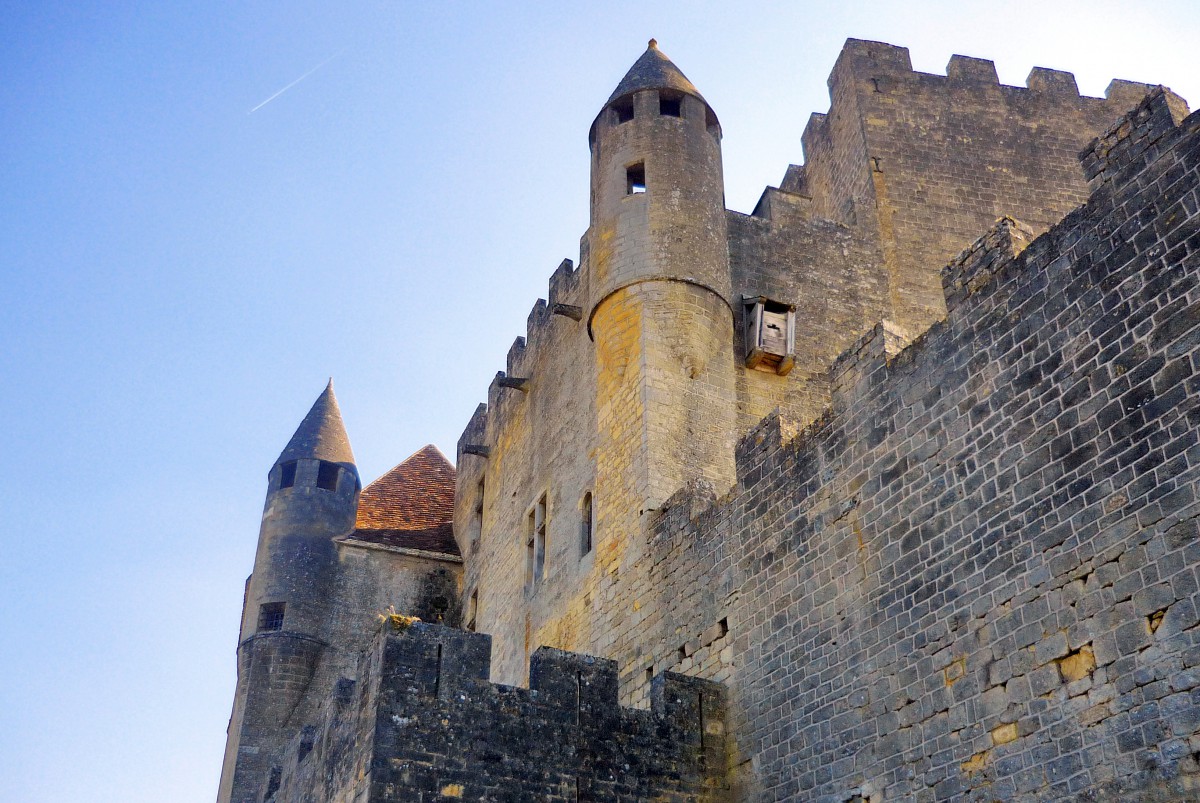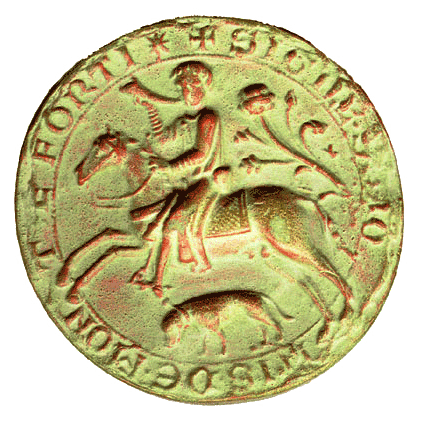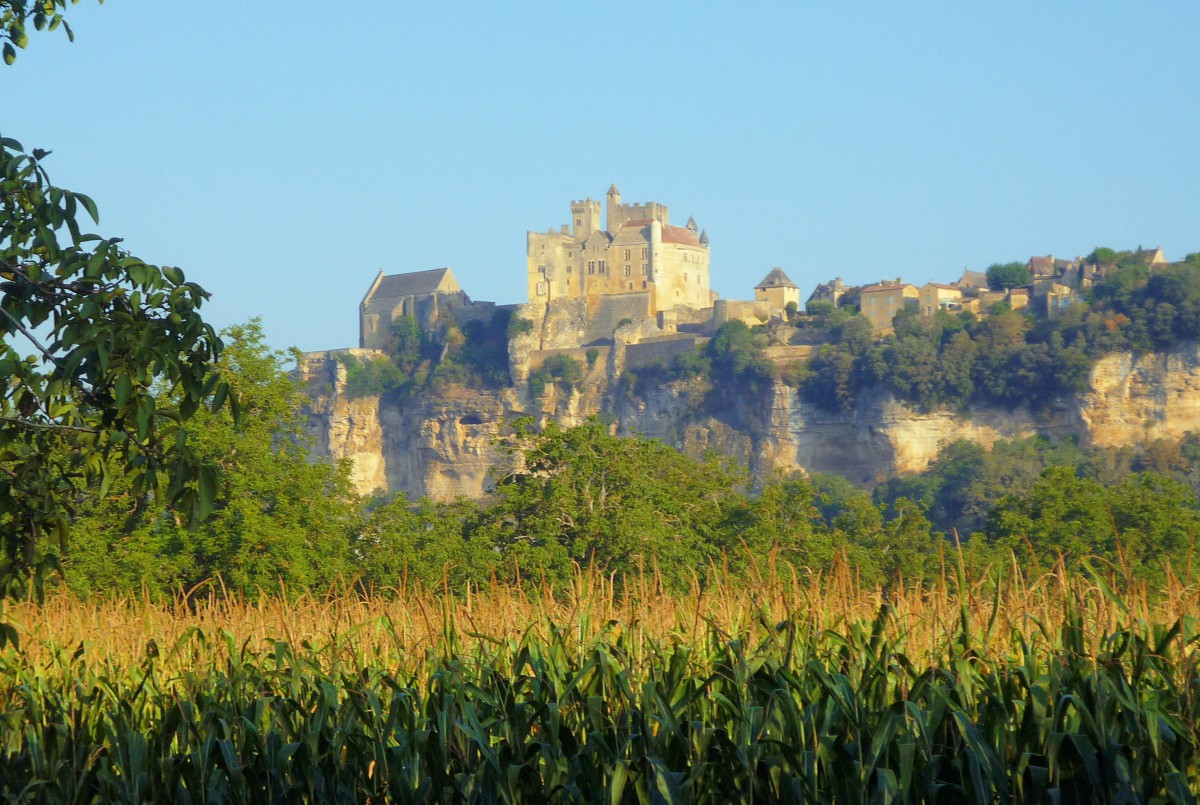The strategic position of the village of Beynac-et-Cazenac is a point of interest in the Dordogne Valley which can not be ignored. From the very start, the village will charm you with its cobbled, steep little lanes and stairways which climb up to the formidable castle, where the view is simply breathtaking. It is therefore unsurprising that Beynac gained the prestigious title of “one of the most beautiful villages of France” with its houses clinging majestically to the cliff-face.
The village of Beynac
For many centuries, the motto of Beynac’s inhabitants has been “Sem de Bainac e n’avem pas paur!” (“We are from Beynac and we do not fear”). This motto finds its origins in the grand military past of the site.

Beynac was known as “Beinacum” in 1147, “Beynachas” in 1187, and “Bainac or Benaco” throughout the Middle-Ages. The locality takes its name from someone who lived through the Barbarian Invasions of the 5th and 6th centuries. The suffix ”–ac” derives from “–acum”. It was added to the name of the rural landlords that lived there in the 3rd century A.D. This explains why so many places in southwest France have names ending in “-ac”: Bergerac, Jarnac, Cognac, La Roque-Gageac, Figeac, Montignac…

From the end of the 14th century, Beynac was the seat of one of the four baronies of Périgord, along with Biron, Bourdeilles and Mareuil.
The barrys
At the foot of the castle, the town of Beynac was organised into five districts (or barrys). A series of ramparts and fortified gates protected the districts.
The harbour barry was a very active part of the town. In the past, the traffic on the Dordogne River was intense. ‘Gabares’ (scows) unloaded their goods from Auvergne, Quercy and Bordeaux. Fishermen sold the salmon they caught in the river. This trend which continued until the 19th century.
The Sarrazis barry was located next to the Moor spring, where fruit vegetables were cultivated.
The barry around the Rue de la Balme – the main road of the village – played host to merchants, weavers and basket makers.
From the French Revolution until the mid-19th century, the village enjoyed a prosperous trade. Fishing, agriculture, hemp culture building industries benefited from the village’s central position in the Dordogne Valley.
One of the most beautiful villages of France
On the 15th August 1827, the hamlet of Cazenac, located 5 km away, was annexed to the municipality of Beynac. The name of the commune became Beynac-et-Cazenac.
In 1982 Beynac-et-Cazenac was listed as one of the Most Beautiful Villages of France. You have to admire some of the beautiful stone houses which border the village’s narrow lanes at the foot of the castle.
On the road leading to the castle’s carpark is the ‘archaeological park’. It is made up of neolithic structures that have been recently built using traditional techniques.

You will find a lot of tourist activity in the Summer months. Many cafés and restaurants are found in the village, as well as souvenir shops and other stores selling jewellry, antiques and art works.
Beynac Castle, the highlight of the village

Towering on a limestone crag 150 metres above the Dordogne River, the impregnable and austere Beynac Castle stands as one of the most important castles in the region. This strategic position on the plateau atop the cliff had a direct influence on the castle’s defence architecture.
Historic overview of the castle
It is believed that the plateau of the castle was first inhabited during the Bronze Age. After the Barbarian Invasions and the Vikings attacks, the feudality reorganised itself during 10th century. Hélie, the first lord of Beynac known to us, set up a castrum on the rock spur in the year 1050.

The first mention of the castle
The first unquestionable mention of the castle dates back to 1115. That year, Maynard de Beynac undertook the building of a mighty fortress around the former keep on the plateau. In 1194, Adhémar de Beynac returned from the Crusades and died without direct descendants.
Richard the Lionheart and Beynac
This inspired Richard the Lionheart, with his title of Duke of Aquitaine (and direct suzerain), to claim the stronghold. Having succeeded in doing so, he entrusted the fortress to his lieutenant Mercadier. The latter was feared throughout the region. His mobs pillaged the villages of Périgord on behalf of the English. When Richard the Lionheart died in the battle of Châlus in March 1199, Mercadier entered the service of John Lackland. He then ravaged Gascony and the city of Angers.
On Easter Monday, 10th April 1200, Mercadier was assassinated whilst paying homage to Eleanor of Aquitaine in Bordeaux. The assassin, Brandin, was a rival mercenary in the service of the King of England. From that year onwards, Beynac Castle came back into the Beynacs’ possession.

Simon de Montfort and the Albigensian crusade
In 1214, Catholic knight Simon de Montfort led his Albigensian crusade in Périgord. There, he chased everyone who supported Catharism. The friendship shared between the lords of Beynac and Raymond, Count of Toulouse (and great protector of Catharism) incurred Simon de Montfort’s anger. He then conquered the castle and dismantled its defences. But the Lord of Beynac managed to keep his fief. He took the opportunity to rebuild it into an even mightier fortress. In his 13th century chronicles of the Albigensian Crusade, Cistercian monk Peter of Vaux de Cernay referred to Beynac Castle as “Satan’s Arch”. This gives an idea of the powerful and fearful reputation of the Lords of Beynac.
In 1259, the Treaty of Paris stipulated that Louis IX of France had to yield Périgord to the English King Henri III. Thus Beynac became English.

In 1328 Philip VI of Valois became King of France. His first action was to confiscate Guyenne (including Beynac and Périgord) from the King of England. The Treaty of Brétigny in 1360 reversed the situation and France once again ceded Guyenne to England… Until 1368 when the French changed their minds and decided to keep Beynac for good!
In 1370, the sole heiress of Beynac was a three year-old girl. She was promised for marriage to her uncle, Pons de Commarque. The man was knowns to have driven the English out of the Sarlat region. By his marriage, he became the most powerful lord in all Périgord.
A castle built in a strategic location
The castle was built in a strategic location dominating the Dordogne valley. In fact, the Dordogne river then marked the border between the French and English territories. Beynac Castle and Marqueyssac Castle were closely observing those of Castelnaud and Fayrac (on the English side).
Beyond the conflict between two kingdoms, the rival lords of Beynac and Castelnaud were also fighting each other to attempt to affirm their own power over Périgord. In 1442 the King of France Charles VII, successfully besieged Castelnaud with the help of Pons de Beynac. Consequently the fief of Beynac was granted the seat of one of the four baronies of Périgord. In the aftermath of the Hundred Years’ War, the valley rediscovered peace. But the territory was unfortunately all but ruined by this stage. The rebuilding process started in line with the birth of the Renaissance in France.

The castle was entirely protected by the cliff on the side facing the Dordogne River. But its northern side gave way to the unprotected plateau. Thus in 1598 the lords of Beynac reinforced its defences by building a double curtain wall, two rows of moats and two barbicans.
Beynac from the 15th to the 19th centuries
Barons by the end of the 15th century, the Beynacs were heavily involved in the political and military future of Périgord.
The Wars of Religion seriously reduced the prosperity of Beynac. The region also suffered from several peasant revolts (les croquants). The parish church, Saint Jacques was burnt down.

At the beginning of the 17th century, the King rewarded Beynac by elevating the Lords to the rank of Marquis. Isaac de Beynac (died in 1687) became involved in the Rohan Wars. He then supported the Prince of Condé during the Fronde.
In 1753, the last male heir of Beynac died. His lands came into the possession of Christophe de Beaumont, who married the daughter, Marie-Claude de Beynac on the 10th March 1761. The Beaumonts abandoned Beynac Castle. In the end of the 19th century they came back to reside in the castle.
The castle today
The renovations they started drove them into bankruptcy. And despite being listed as an historical monument, the castle was purchased by a private individual in 1961. Since then, Beynac Castle has undergone restoration work. This is planned to continue until 2030, in an attempt to return it to the way it was during the Middle-Ages.
The fantastic setting of Beynac Castle has been the stage for many movies over the last decades.
- ‘La fille de d’Artagnan’ by Bertrand Tavernier (1993),
- ‘Les Visiteurs 1 and 2’ by JM Poiré (1993 and 1996),
- ‘Jeanne d’Arc’ by Luc Besson (1998),
- ‘Chocolat’ by Lasse Hallström (2000) [the village only], and
- ‘Fanfan la Tulipe’ by Gérard Krawczyk (2003).
Visit of Beynac Castle

Visits to Beynac Castle have been organised in such a way that visitors discover it the same way a knight would have, upon first arriving at the fortress.
The guardroom
Past the esplanade, the double wall and the first gatehouse, the visit begins in the dark guardroom lit up with oil lamps, as it was during medieval times. Knights entered this atmospheric room on horseback. Stalls for the horses can still be seen there today. You may have noticed that Beynac Castle was built with impressively thick walls. To show their determination to keep the castle impregnable, the builders neither cut windows in the walls. Nor had fireplaces at the base of the fortress.

Having dismounted, a knight would climb the narrow spiral staircase at the rear of the guardroom. The reason for the narrowness of the stairway was to give an advantage to the defenders, as the invaders could only climb the stairs in single file, thus making them easier to attack at the top.
The Hall of State
The next floor features the 14th century kitchen and its two fireplaces. Above it is the great Hall of State and the apartments with loamed floors and whose mullioned windows offer a formidable view over the Dordogne Valley.

The Hall of State (or sometimes known as the Great Hall) was the meeting place of the four barons of Périgord: Beynac, Biron, Bourdeilles and Mareuil. The Italian-style fireplace is adorned with carvings. The hall is adjacent to a small oratory with frescoes.
The drawing room
Another set of stairs from the 17th century leads up to a drawing room furnished with Louis XIII-style furniture and interesting wood paintings on the ceiling.

The caste terrace
The last staircase to the top of the keep climbs up to the watch-point, which looks towards the south bastion where the panoramic view encompasses the Dordogne Valley and the castles of Marqueyssac, Castelnaud, and Fayrac.

The castle’s kitchen
On the way down, the visit ends with a look at the 13th century kitchen, before crossing the drawbridge and finally reaching the barbican.

The chapel
Before leaving the Castle plateau, be sure to visit the Romanesque Chapel with its roof of lauzes, which was given to the municipality of Beynac-et-Cazenac.

How to get to Beynac

The Dordogne Valley is easily accessible by car from Paris, Bordeaux and Toulouse, via the A20 and A89 autoroutes (French for motorways). Beynac is situated not far from Sarlat-la-Canéda (12 kms) via the D57 road.
For UK visitors, the closest airport from Beynac is Brive-Souillac Airport (50 kms / 1hr trip by car) with direct flights to London-Stansted.
If you travel from Australia or America, you could take a flight to Paris Charles de Gaulle, and travel by TGV from the airport station straight to Bordeaux and rent a car from there.
The TGV from Paris-Gare de Montparnasse takes 3 hours to Bordeaux. A SNCF coach links Sarlat to the train station of Libourne which has direct trains to Bordeaux.
Did you find what you read interesting? If so, please do share this article on Facebook or twitter!
For more information about Beynac, visit the tourist website.
Inspired? Pin them for later:












